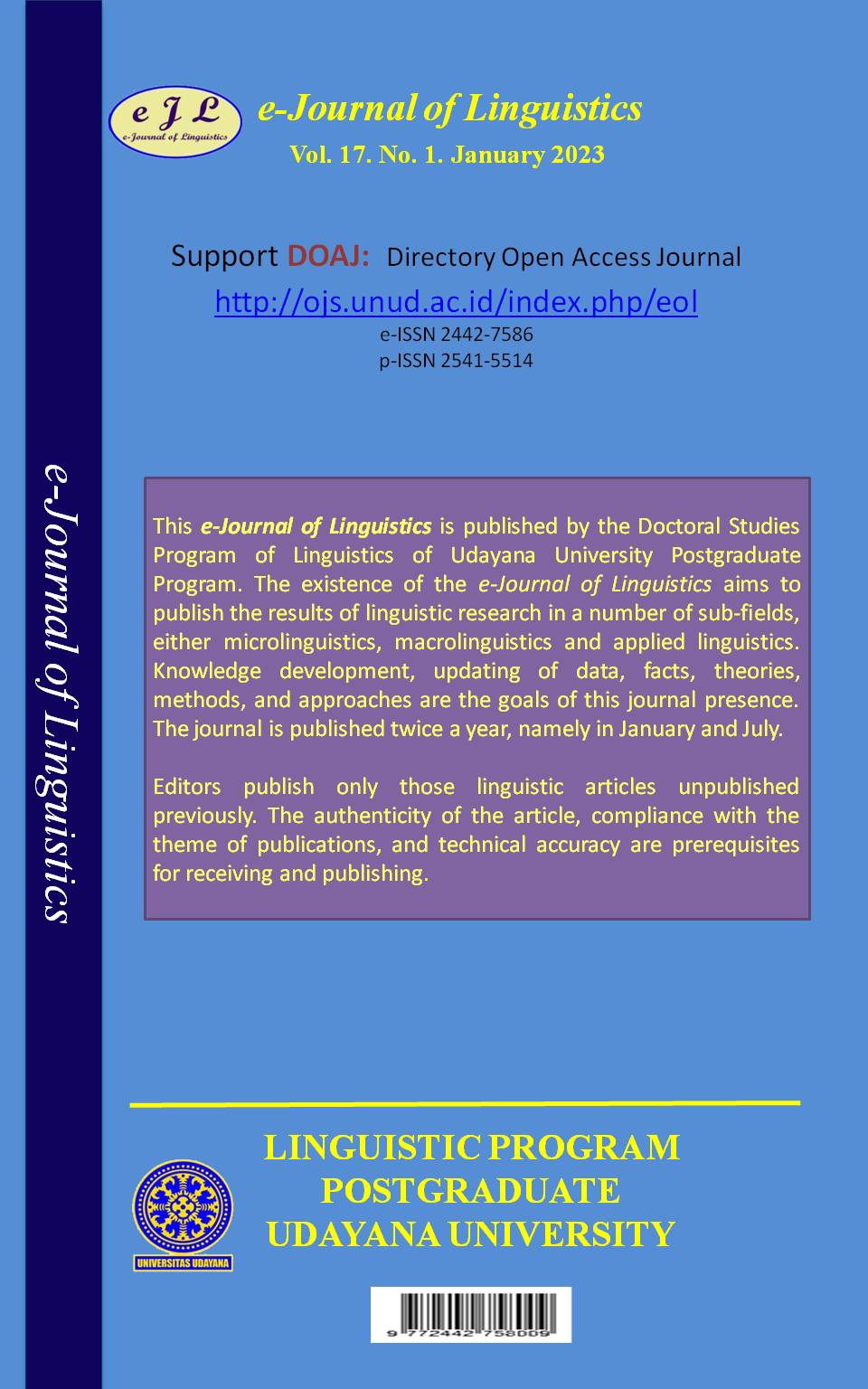en
en
Abstrak
The widespread use of English is depicted in the Linguistic Landscape (LL) in Tulungagung competes the Indonesian language (the national language) and Javanese language (the local language). The present study is aimed (1) to view the position of English language among the existing languages, (2) to investigate what motive that urges a signage owner in acquiring English, and (3) to explain the role performed by English in society. A descriptive qualitative method in research is carried out to explain the phenomenon. Data were collected from an observation of languages appear on signage and an interview to the signage owner. This study is set up in Tulungagung Regency that characterized as the Central Business District (CBD). From the total 460 photographed signages observed and the interviews done, it is shown that English in society is not more dominant than the Indonesian language in use as explained by Landry & Bourhis (1997) but as the interviews done with the signage owner, it narrates that English carries some characterization proposed by Piller (2001) that urge a party to acquire English and it also plays significant roles in society, specifically in business field as stated by Lee (2019). Thus, it challenges the use of local language, the Javanese language, since English appears within its excellence.
##plugins.generic.usageStats.downloads##
Referensi
Alrajafi, G. (2021). The use of English in Indonesia: Status and Influence. SIGEH ELT : Journal of Literature and Linguistics, 1(1), 1–10. https://doi.org/10.36269/sigeh.v1i1.355
Aristova, N. (2016). English Translations in the Urban Linguistic Landscape as a Marker of an Emerging Global City: The Case of Kazan, Russia. In Procedia - Social and Behavioral Sciences (Vol. 231, pp. 216–222). https://doi.org/10.1016/j.sbspro.2016.09.094
Baruah, T. D. (2012). Effectiveness of Social Media as a Tool of Communication and Its Potential for Technology Enabled Connections: A Micro-level Study. International Journal of Scientific and Research Publications, 2(5), 1–10. https://doi.org/ISSN 2250-3153
Cenoz, J., & Gorter, D. (2008). The Linguistic Landscape as An Additional Source of Input in Second Language Acquisition. IRAL - International Review of Applied Linguistics in Language Teaching, 46(3), 267–287. https://doi.org/10.1515/IRAL.2008.012
Duizenberg, M. R. (2020). Linguistics Landscape: A Cross Culture Perspective. Linguistics and Culture Review, 4(1), 15–28. https://doi.org/10.37028/lingcure.v4n1.17
Fakhiroh, Z., & Rohmah, Z. (2018). Linguistic Landscape in Sidoarjo City. NOBEL: Journal of Literature and Language Teaching, 9(2), 96–116. https://doi.org/10.15642/nobel.2018.9.2.96-116
Gorter, D. (2006). Introduction: The Study of The Linguistic Landscape as A New Approach to Multilingualism. Linguistic Landscape: A New Approach to Multilingualism, 3(1), 1–6. https://doi.org/10.21832/9781853599170-001
Guy, P. (2016). Linguistic Landscapes. 1–10. https://doi.org/10.1093/oxfordhb/9780199656431.013.16
Kartika, A. D. (2019). Lanskap Linguistik, Multilingualisme, dan Sikap Bahasa Masyarakat Surabaya. 1–6.
Kulzer, M. (2018). The Wow-Theory: Investigation of Wow Experiences with Interactive Technologies and Development of a Measurement Tool. ResearchGate, May 2018.
Landry, R., & Bourhis, R. Y. (1997). Linguistic Landscape and Ethnolinguistic Vitality: An Empirical Study. Journal of Language and Social Psychology, 16(1), 23–49. https://doi.org/10.1177/0261927X970161002
Lanza, E., & Woldemariam, H. (2014). Indexing Modernity: English and Branding in The Linguistic Landscape of Addis Ababa. International Journal of Bilingualism, 18(5), 491–506. https://doi.org/10.1177/1367006913484204
Lauder, A. (2008). The Status and Function of English in Indonesia: a Review of Key Factors. Makara Human Behavior Studies in Asia, 12(1), 9. https://doi.org/10.7454/mssh.v12i1.128
Lee, J. S. (2019). Multilingual advertising in the linguistic landscape of Seoul. World Englishes, 38(3), 500–518. https://doi.org/10.1111/weng.12427
Piller, I. (2001). Identity Constructions in Multilingual Advertising. Language in Society, 30(2), 153–186. https://doi.org/10.1017/S0047404501002019
Piller, I. (2003). Advertising As a Site of Language Contact. Annual Review of Applied Linguistics, 23, 170–183. https://doi.org/10.1017/s0267190503000254
Rabiah, S. (2018). Language as a Tool for Communication and Cultural Reality Discloser. International Conference on Media, Communication and Culture Rethinking Multiculturalism: Media in Multicultural Society, 1–11. https://osf.io/preprints/inarxiv/nw94m/
Rachmawati, I., Sary, F. P., & Perdani, D. R. (2016). Influence of the Use of Brands in a Foreign Language (English) on the Purchase Decision Process of Cosmetic Products Made in Indonesia. Pertanika Journal of Social Sciences and Humanities, 24(July), 51–62.
Rahman, A., Yap, N. T., & Darmi, R. (2018). The Association between Vocabulary Size and Language Dominance of Bilingual Malay-English Undergraduates. 3L: Language, Linguistics, Literature, 24(4), 85–101. https://doi.org/10.17576/3L-2018-2404-07
Rao, P. S. (2019). The Role of English as A Global Language. Research Journal of English, July.
Rogerson-Revell, P. (2007). Using English for International Business: A European case study. English for Specific Purposes, 26(1), 103–120. https://doi.org/10.1016/j.esp.2005.12.004
Rohmah, Z. (2005). English as a Global Language: Its Historical Past and Its Future. Jurnal Bahasa & Seni, 33(1), 106–107. http://sastra.um.ac.id/wp-content/uploads/2009/10/English-as-a-Global-Language-Its-Historical-Past-and-Its-Future-Zuliati-Rohmah.pdf
Rusnaningtyas, E. (2014). The Language Used in The Linguistic Landscape Found in The Western Part of Surabaya. 26.
Sahril, S., Harahap, S. Z., & Hermanto, A. B. (2019). Lanskap Linguistik Kota Medan: Kajian Onomastika, Semiotika, Dan Spasial. MEDAN MAKNA: Jurnal Ilmu Kebahasaan Dan Kesastraan, 17(2), 195. https://doi.org/10.26499/mm.v17i2.2141
Setiawan, S. (2001). Language Shift in a Bilingual Community: The Case of Javanese in Surabaya, East Java. Auckland University New Zealand, February, 1–154.
Setiawan, S. (2013). Children ’ s Language in a Bilingual Community in East Java. ResearchGate, October.
Sirbu, A. (2015). The Significant of Language as a Tool of Communication. PROQUEST SciTech Journals, XVIII(2), 405–406. http://www.thefreedictionary.com/dialect
Yannuar, N., & Tabiati, S. E. (2016). Public Signs in The City of Malang: A study on The Linguistic Landscape of Indonesia. The Changing Face of Language Pedagogy: Exploring Linguistics and Literature, October 2016, 123–138.
Zakiyyatul Fakhiroh. (2018). 2018 J. Zakiyyatul Fakhiroh et al. Linguistic Landscape of Sidoarjo City.pdf.
Zein, S. (2019). English, Multilingualism and Globalisation in Indonesia. English Today, 35(1), 48–53. https://doi.org/10.1017/S026607841800010X

This work is licensed under a Creative Commons Attribution 4.0 International License




